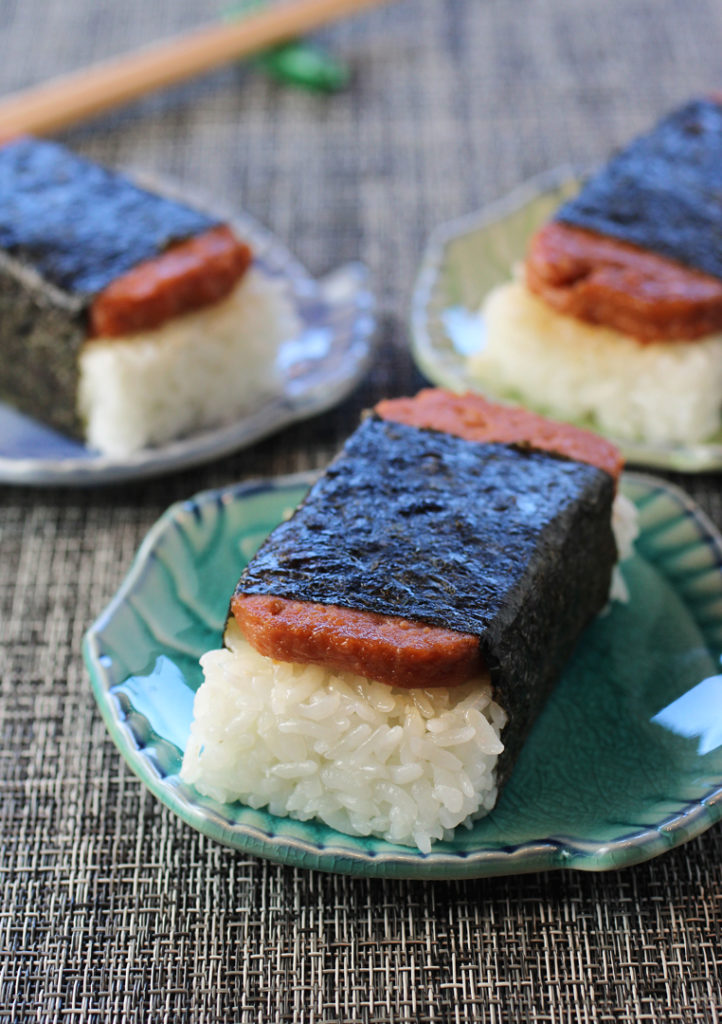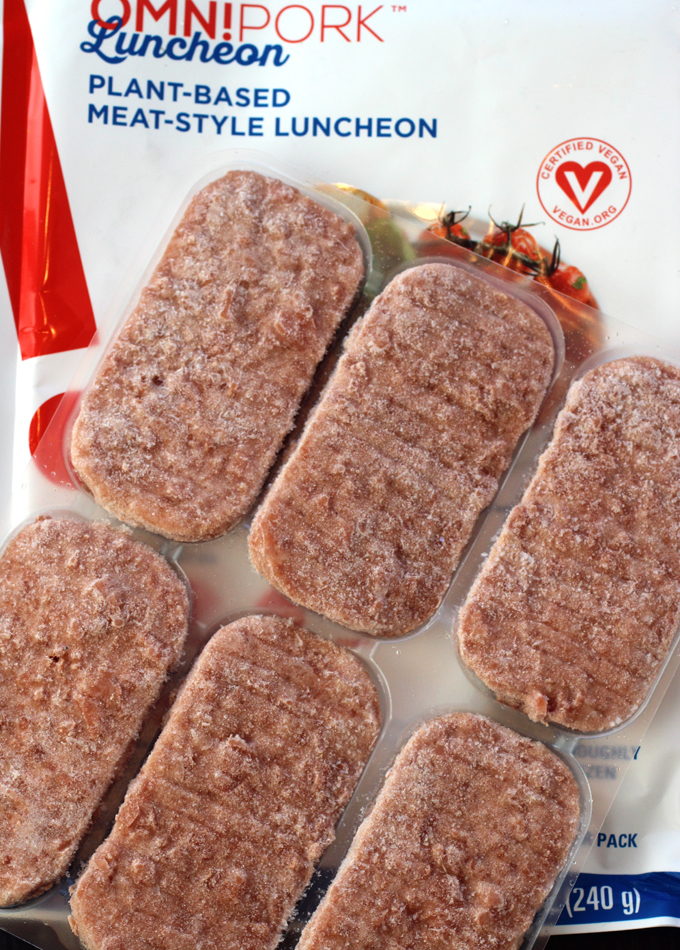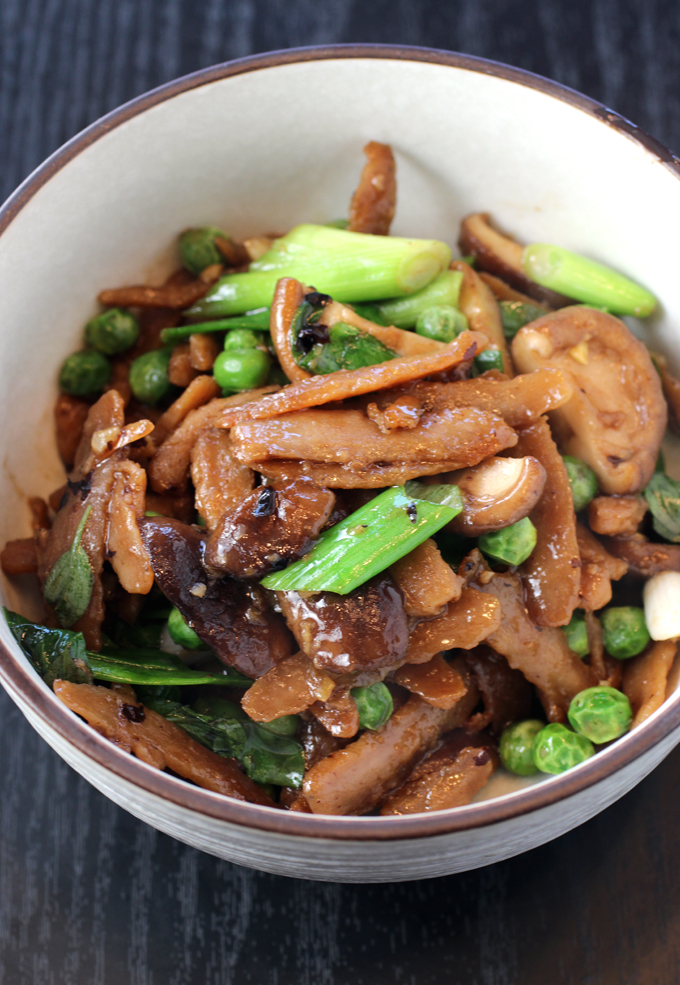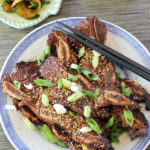A “Spam” Musubi That’s Vegan

It looks exactly like everyone’s guilty-pleasure Hawaiian snack food.
Only this musubi is vegan.
Indeed, this one spotlights a new plant-based version of Spam.
To the growing list of faux “beef,” “chicken,” and other proteins now comes OmniPork.
Designed to mimic pork, it’s made from a blend of non-GMO soy, peas, shiitake mushrooms, and rice. It was developed in Canada by food scientists for Hong Kong-based food innovation company, Green Monday, which owns OmniFoods.
It’s available in three forms — OmniPork Ground, Strips, and Luncheon, each for $5.99 per package. All three can be found in the freezer cases of Sprouts; while the Strips and Ground are carried by select Whole Foods.
When I received samples of all three, I went straight for the Luncheon first, curious to see how it would compare to the familiar stuff in a can. The verdict? Quite impressively.
For musubi, saute the Luncheon slabs from frozen in a pan with soy sauce, sugar and mirin to glaze them. Then, form freshly cooked rice into bricks, top with a Luncheon slice, and lastly wrap with nori.

As you can tell from the photo, it looks all the world like a classic musubi. When you bite into it, you don’t have that awkward perplexed reaction of “Yikes, what is this?” Rather, you’re surprised at how flavorful it is. Its texture mimics ground, compressed meat, though, the Luncheon is probably a little fluffier and less dense than real-deal Spam.
A big upside? It tastes much less salty than Spam. In fact, we happened to have an actual can of 25-percent-less-sodium Spam in the cupboard (yes, we are that kind of household). That can has 580mg of sodium, 7g protein, and 180 calories for a 2-ounce serving, compared to the Luncheon that has 200mg of sodium, 5g protein, and 70 calories for a roughly comparable serving.
The Ground is a fine substitute in tacos or stir-fries, as are the Strips. The Strips can even be seared so they take on a nice caramelized color. They have a tender chew to them, almost like real pork that’s been thinly sliced and tenderized with a little baking soda.

My husband, aka Meat Boy, didn’t really miss the meat when he sank his teeth into the musubi or the stir-fry that I made with the Strips, shiitake mushrooms, peas and green onions.
And if you know anything about him, that’s saying a lot.
Enjoy your own musubi, using the recipe below from the cookbook, “Aloha Kitchen: Recipes from Hawai’i” (Ten Speed Press, 2019) by Alana Kysar. It’s designed to be made with Spam, but adapts easily to the Luncheon slices, too.
Soy-Glazed Spam Musubi
(Makes 8 musubi)
2 tablespoons soy sauce (shoyu)
2 tablespoons light brown sugar
1/2 teaspoon mirin (optional)
1 to 2 teaspoons neutral oil
One package of frozen Omni Pork Luncheon or a 12-ounce can of Spam Less Sodium, cut horizontally into 8 slices
3 sheets roasted sushi nori, cut into thirds crosswise
2 teaspoons furikake
5 to 6 cups cooked short-grain rice
In a small bowl, whisk the soy sauce, brown sugar, and mirin (if using) together. Set aside.
Lightly coat the bottom of a large skillet with the oil and heat over medium heat. Fry the Spam or Luncheon slices until evenly browned and crispy, 2 to 3 minutes on each side (or a minute or two longer for the Luncheon because it’s cooked from frozen). Turn the heat to low for the last minute of cooking, then turn off the heat. Pour in the soy mixture and quickly turn the Spam or Luncheon slices to evenly coat them. The mixture will cook down in less than a minute, so don’t walk away for this part or your glaze may burn. Immediately transfer the Spam or Luncheon slices, with glaze, to a plate.
Place a strip of nori, rough side up, on a cutting board or clean work surface. Place the Spam musubi maker mold (available at Japanese markets) over it, in the middle, then place a slice of Spam or Luncheon in the mold. Alternately, if you don’t have a mold, you can line a cleaned Spam can with plastic wrap instead. Sprinkle 1/4 teaspoon of furikake over the Spam, then fill the mold with a generous mound of rice. Press the rice firmly with the musubi maker press until it is 3/4 to 1-inch thick, adding more rice as necessary. Use the press to hold the rice down with one hand and pull the mold upward to unmold the musubi with your other hand. If you’re using the Spam can, simply pull the plastic wrap from the can to unmold. Wrap the nori around the Spam-rice or Luncheon-rice stack, bringing both ends of the strip to the middle, folding one over the other, and flipping it over so the seam is down and the Spam or Luncheon is facing up. Repeat with remaining ingredients. Serve immediately or wrap with plastic wrap to take with you on the go.
Adapted from “Aloha Kitchen” by Alana Kysar

Another Recipe by Alana Kysar to Enjoy: Maui-Style Kalbi Short Ribs

I too have an actual can of 25-percent-less-sodium Spam in the cupboard! Will be bookmarking this recipe and adding the product to my list for next trip to Sprouts. Thanks for a great even lower sodium tip, Carolyn!
Hi Carroll: Remember when Spam was in short supplies during the height of the pandemic, too? It’s great to discover an alternative that is less salty, too. I hope you enjoy the Luncheon slices. They really were surprisingly good.